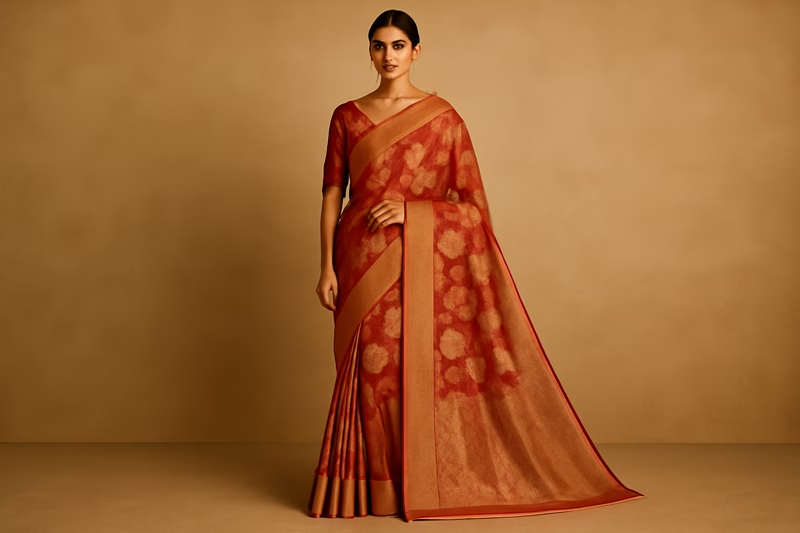Banarasi Saree
Banarasi Saree is handwoven with love in the ancient city of Varanasi (also called Banaras), these sarees are famous for their incredible richness. There’s something absolutely magical about a Banarasi saree. Whether you’ve watched your mother lovingly unfold one on a festive morning, or dreamed of your own wedding look shimmering in intricate gold threads, the Banarasi saree is like a piece of Varanasi’s soul woven into six yards of pure grace.

Why Are Banarasi Sarees So Special?
Banarasi sarees come from the ancient city of Varanasi (also known as Banaras), a place where skilled weavers have been passing down their artistry for generations. Each saree tells a story—of heritage, culture, and the timeless drive to create something exquisite. These sarees aren’t just clothing; they’re treasures that often become family heirlooms, lovingly handed down from mothers to daughters. Every women will feel the pride of having the Rich Banarasi Sarees. They’re crafted from the finest silk, often heavy and smooth to the touch, but the real showstopper is the intricate embroidery.
A Rich History Woven in Silk
Wearing a Banarasi saree feels like wrapping yourself in history. Decades ago, these sarees were adorned by royalty, and that regal touch lingers on today. What sets them apart? Intricate designs—think florals, bold brocade borders, and that unmistakable “zari” work using gold or silver threads. Whether you see them in classic reds and golds during North Indian weddings or pastel beauties at summer celebrations, their elegance is undeniable.
The Many Faces of Banarasi
Not all Banarasi sarees are the same! Here are a few classics:
- Katan: Pure silk, lightweight yet rich.
- Organza: Sheer with delightful zari threads.
- Georgette: A bit lighter—perfect for festive days and summer weddings.
- Shattir and Brocades: For those who like textured grandeur.
Draping the Banarasi: Classic and Contemporary
Draping a Banarasi saree might feel daunting at first—but don’t worry. Start with a well-fitted petticoat for support and neatly pleat the fabric around your waist. Pin the pleats so they stay in place, and gracefully drape the pallu over your shoulder. Want to jazz it up? Here are some style tricks:
- Try a belted drape for a contemporary twist.
- Pair with a trendy blouse—crop tops, jackets, or classic puff sleeves.
- Add a statement necklace and big chandbalis for drama.
Choosing Your Perfect Banarasi
Keep these in mind while shopping:
- Go by occasion: Silk for weddings, lightweight georgette for day events.
- Choose colors wisely: Pastels suit daytime, bold tones for evenings. Pick what complements your skin tone.
- Check for authenticity: Look for Mughal-inspired motifs, quality silk and zari, and, if possible, a certification from the Silk Mark Organization of India.
Make it Your Own
Banarasi sarees can be as modern or traditional as you want.
- Drape it the classic Bengali or South Indian way.
- Style with belts, potli bags, or even wear as a lehenga for a fresh fusion look.
- Don’t forget comfy footwear; block heels or pretty juttis work best so you move with confidence and grace.
Conclusion
A Banarasi saree is more than just fabric—it’s tradition, artistry, and elegance rolled into one. It belongs at every Indian celebration, in every wardrobe, and in every memory. When you wear one, you’re not just dressing up—you’re standing tall in the beauty of generations. So, the next time you drape one, remember: confidence, poise, and a smile are the best accessories anyone could wear. A saree that drapes beautifully, catches the light with every movement, and instantly adds glamour. Traditionally worn by brides and for very special occasions, a Banarasi isn’t just clothing; a symbol of timeless Indian tradition and unmatched weaving skill. Owning one feels like holding onto a piece of living heritage.
